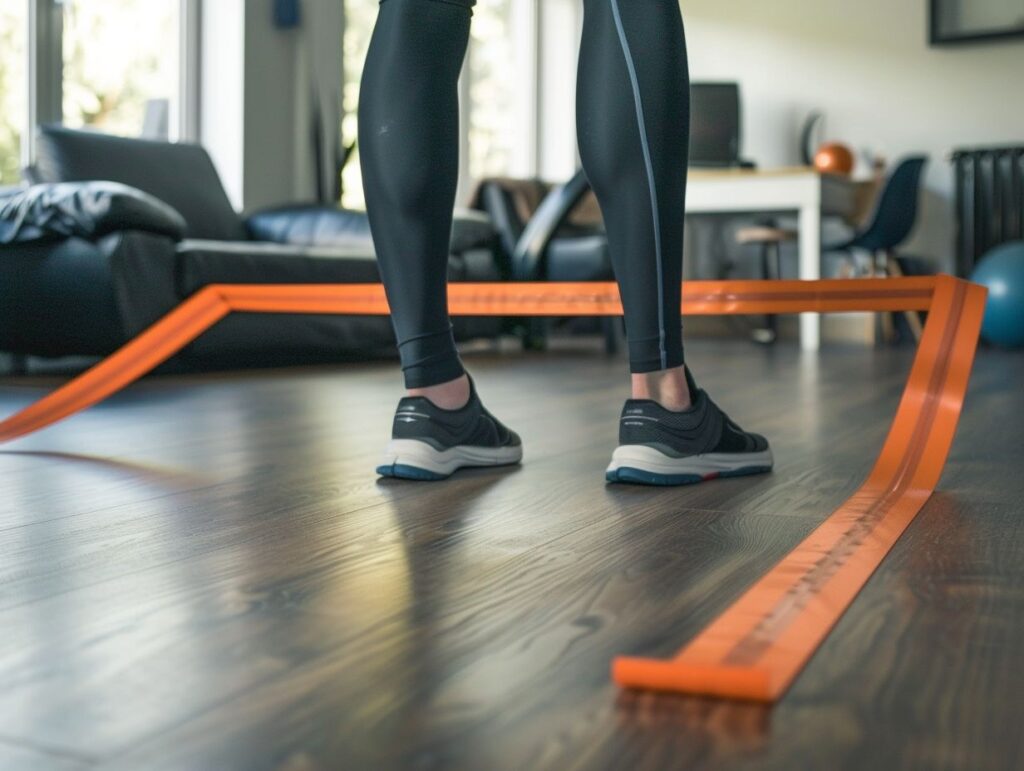Jump rope is not just for kids on the playground anymore. This simple yet effective exercise has gained popularity among fitness enthusiasts for its numerous benefits.
From improving cardiovascular health to burning calories and fat, jump rope offers a full-body workout in a portable and affordable package.
Looking for alternatives to mix up your routine? There are plenty of options to choose from! In this article, we’ll explore the benefits of jump rope and provide you with 10 alternative exercises to keep your fitness regimen exciting and effective.
What Is Jump Rope?
Jump rope, also known as skipping rope, is a popular cardiovascular exercise that involves jumping over a rope as it passes under your feet. It is a versatile fitness tool used for various purposes such as cardio workouts, HIIT training, and cross-training routines.
The beauty of jump rope lies in its simplicity and effectiveness. Whether you’re a beginner looking to boost your endurance or an advanced athlete seeking a high-intensity workout, jump rope can cater to a wide range of fitness levels. Its portable nature makes it a convenient option for both indoor and outdoor workouts, allowing you to switch up your routine with ease. The variability in jump rope techniques, such as double unders, crossovers, and side swings, provides endless possibilities for challenging and engaging workouts.
Why Is Jump Rope Popular?
Jump rope has gained popularity due to its numerous health benefits and its effectiveness as a full-body workout. It is particularly favored for its ability to aid in weight loss, improve endurance, enhance speed and agility, and provide a high-intensity workout.
Many fitness enthusiasts appreciate the versatility of jump rope exercises as they can easily be incorporated into various workout routines. The constant motion required while jumping rope not only burns a significant amount of calories but also engages multiple muscle groups simultaneously, making it a time-efficient exercise option.
The rhythmic coordination needed for successful jump roping helps improve overall balance and coordination skills. This makes it a favorite choice for those looking to enhance their athletic performance or simply add a fun and challenging element to their fitness regimen.
What Are The Benefits Of Jump Rope?
The benefits of jump rope extend beyond just burning calories; it elevates heart rate, enhances endurance, speed, and agility, and offers varying intensity levels to suit different fitness goals. Jump rope provides a comprehensive workout engaging multiple muscle groups and improving overall cardiovascular health.
Improves Cardiovascular Health
Jump rope is highly effective in improving cardiovascular health by boosting cardiorespiratory fitness levels. It elevates heart rate, enhances lung capacity, and strengthens the heart muscle, leading to better overall heart health.
Engaging in jump rope exercises essentially acts as a form of aerobic workout, requiring continuous movement that engages the major muscle groups and stimulates the circulatory system. This sustained physical activity helps to increase the efficiency of the cardiovascular system by promoting better circulation and oxygen delivery throughout the body.
As heart rate increases during jump rope sessions, it challenges the cardiovascular system to adapt and become more resilient over time. The controlled breathing patterns needed during jumping rope work to expand lung capacity, allowing for improved oxygen uptake and utilization.
Burns Calories and Fat
Jump rope is a highly effective exercise for burning calories and fat, making it a popular choice for individuals looking to lose weight or maintain a healthy weight. It is a great addition to any weight loss regimen due to its calorie-burning efficiency.
Jump rope not only helps in shedding excess weight but also torches calories and melts away stubborn fat. The high-intensity nature of jump rope workouts elevates heart rate, leading to increased calorie expenditure, which is vital for weight loss.
By engaging multiple muscle groups simultaneously, jump rope serves as a full-body workout, further enhancing its effectiveness in burning fat efficiently. Consistent jump rope sessions can significantly contribute to achieving weight management goals and improving overall fitness levels.
Increases Coordination and Balance
Jump rope helps in enhancing coordination, agility, and balance through rhythmic footwork and precise rope handling techniques. It challenges the body and mind to work together, improving overall coordination skills.
The dynamic nature of jump rope exercises requires split-second decision-making to time each jump perfectly, engaging various muscle groups for improved agility. This form of agility training not only boosts physical coordination but also sharpens mental focus as individuals strive to maintain a steady rhythm and precise movements. The coordination challenges presented by jump rope activities stimulate proprioception, enhancing one’s spatial awareness and balance through controlled motions and reflex responses.
Improves Bone Density

Jump rope is beneficial for improving bone density and strength, especially in weight-bearing bones like the hips, legs, and spine. The impact of jumping helps in stimulating bone growth and maintaining bone health.
Regular jump rope exercises not only strengthen bones but also help prevent conditions like osteoporosis, which can lead to weakened bones and increased risk of fractures. By engaging in this weight-bearing activity, individuals can enhance their bone mineral density, leading to overall stronger and healthier bones. Jump rope workouts are a great way to promote better balance and coordination, further reducing the risk of falls and bone-related injuries.
Portable and Affordable
Jump rope stands out for its portability and affordability, making it a convenient workout option for individuals who prefer exercising indoors or outdoors. It requires minimal equipment and can be easily incorporated into daily routines.
Due to its light weight and compact nature, a jump rope can be effortlessly carried in a bag or backpack, allowing individuals to squeeze in a quick workout session wherever they go. Whether in a small apartment or a spacious park, this versatile tool offers a complete body workout, helping to improve cardiovascular health, coordination, and endurance. The affordability of a jump rope also makes it an attractive choice for those seeking an effective yet budget-friendly fitness solution.
What Are The Alternatives To Jump Rope?
While jump rope offers excellent fitness benefits, there are several alternative exercises that can provide similar advantages. These exercises range from high-intensity activities like high knees and burpees to more leisurely options like hula hooping and dancing.
High Knees
High knees is a dynamic cardiovascular exercise that boosts heart rate, enhances agility, and offers a high-intensity workout. It involves lifting the knees towards the chest alternately while maintaining a fast pace.
This exercise is incredibly effective for improving cardiovascular fitness as it gets the heart pumping and blood circulating throughout the body.
The rapid movement of raising the knees challenges the cardiovascular system and helps to increase overall endurance.
High knees are known for their agility-enhancing benefits, as they require coordination, balance, and quick footwork.
The high-intensity nature of this workout makes it a popular choice for individuals looking to burn calories and elevate their heart rate for a significant cardio workout.
Mountain Climbers
Mountain climbers are a core-intensive exercise that provides a full-body workout, targeting multiple muscle groups simultaneously. This exercise enhances endurance, builds core strength, and improves overall stability.
Mountain climbers require dynamic movements that engage the abdominal muscles, obliques, and lower back, resulting in improved core stability and muscular endurance. By incorporating mountain climbers into your routine, you can boost your cardiovascular fitness, hone your coordination, and increase your metabolism. This versatile exercise also helps to develop upper body strength as your shoulders, chest, and arms work to maintain proper form throughout the movement, making it a beneficial addition to any fitness regimen.
Burpees
Burpees are a popular high-intensity exercise that combines strength training with cardio, providing a full-body workout. They are effective for building strength, increasing heart rate, and improving overall conditioning.
This exercise involves squatting, jumping back into a plank position, performing a push-up, and then jumping back to the starting position. The rapid succession of movements in burpees makes it a quintessential example of a high-intensity interval training (HIIT) exercise.
The explosive nature of burpees engages multiple muscle groups simultaneously, making it a great functional training workout that improves coordination, flexibility, and endurance. By incorporating burpees into your fitness routine, you can experience accelerated calorie burn, enhanced cardiovascular fitness, and heightened strength across various muscle groups.
Box Jumps

Box jumps are plyometric exercises that focus on explosive power and lower body strength. They involve jumping onto and down from a raised platform or box, challenging the muscles to generate force quickly.
By engaging in box jumps regularly, individuals can enhance their explosiveness and agility, contributing to improved athletic performance and functional movement capabilities. This exercise not only targets the quadriceps, hamstrings, and glutes but also aids in developing coordination and balance.
The repetitive nature of box jumps helps in increasing the fast-twitch muscle fibers’ activation, crucial for power-based activities. Incorporating variations like single-leg box jumps or depth jumps can further intensify the challenge, pushing individuals to elevate their plyometric abilities and lower body strength.
Jumping Jacks
Jumping jacks are classic calisthenic exercises that improve coordination, agility, and cardiovascular fitness. They involve jumping out with the legs while raising the arms overhead and then returning to the starting position.
This dynamic exercise works multiple muscle groups simultaneously, making it an efficient full-body workout. The coordination required in synchronizing the arm and leg movements helps enhance overall body awareness and balance.
Regularly incorporating jumping jacks into your workout routine can also boost your heart rate, improving cardiovascular endurance. The repetitive nature of this exercise can help improve rhythm and timing, which are essential components of coordination training.
Whether done as a warm-up, a standalone activity, or part of a circuit, jumping jacks offer a fun and effective way to enhance your fitness level.
Skipping
Skipping, similar to jump rope, is a cardio exercise that enhances coordination and agility. It involves jumping over an imaginary rope with rhythmic movements that engage the whole body.
This form of exercise not only boosts cardiovascular health but also helps in improving hand-eye coordination and overall balance. The rhythmic nature of skipping requires precise timing and coordination between the hands and feet, promoting better motor skills.
The repetitive motion of skipping can enhance proprioception, which is the body’s ability to sense its position in space. By incorporating various footwork patterns and increasing the intensity, individuals can challenge their coordination abilities while enjoying a fun and effective workout.
Hula Hooping
Hula hooping is a fun and rhythmic exercise that engages the core muscles and promotes coordination. It involves rotating a hoop around the waist, hips, or arms in a continuous motion.
Engaging in hula hooping not only provides a great workout for your core, but also offers a rhythmic and enjoyable way to burn calories and stay active. The repetitive circular motion of hula hooping helps to strengthen and tone your abdominal muscles, obliques, and lower back. This enjoyable exercise can be done almost anywhere, making it a convenient option for those looking to add some fun and excitement to their fitness routine. With practice, you can master various hula hooping tricks, adding an element of creativity and challenge to your workout.
Stair Climbing
Stair climbing is a challenging lower body workout that enhances endurance and offers an intense cardio session. It involves climbing up and down stairs repeatedly to engage leg muscles and elevate heart rate.
This form of exercise not only targets major muscle groups like quadriceps, hamstrings, and calf muscles but also helps in toning and strengthening them.
By incorporating stair climbing into your fitness routine, you can effectively build lower body strength while improving your cardiovascular fitness.
The repetitive motion of climbing stairs provides a dynamic way to work on your endurance levels and burn calories efficiently.
Stair climbing offers a high-intensity interval training (HIIT) element, making it a time-efficient yet effective option for your overall physical well-being.
Dancing
Dancing is a dynamic and rhythmic form of exercise that enhances coordination, rhythm, and provides a fun way to stay active. It involves moving to music with various dance styles and routines.
This rhythmic movement not only boosts physical fitness but also engages the mind, requiring focus and attention to memorize choreography and follow the beat. The coordination involved in dancing helps improve balance and agility, making it a great alternative exercise to jump rope for those looking to mix things up.
The enjoyable and social aspect of dancing can make it feel less like a workout and more like a recreational activity, making it easier to stay motivated and consistent with regular exercise routines.
10. Shadow Boxing

Shadow boxing is a solo boxing exercise that improves agility, coordination, and cardiovascular fitness. It involves throwing punches and defensive moves in the air without a physical opponent.
By incorporating boxing-inspired movements into your workout routine through shadow boxing, you can enhance your overall physical fitness while learning valuable self-defense techniques. This dynamic exercise not only boosts your cardiovascular endurance but also strengthens your muscles and core stability.
Shadow boxing is a versatile activity that can be tailored to different fitness levels, making it a suitable option for beginners and seasoned athletes alike. The repetitive motion of punching and dodging helps improve hand-eye coordination and reflexes, leading to more precise and controlled movements during actual boxing workouts.
Frequently Asked Questions
What are some jump rope alternatives for cardio workouts?
Some jump rope alternatives include high knee running, jumping jacks, burpees, mountain climbers, and shadow boxing.
Can I use resistance bands as a jump rope alternative?
Yes, resistance bands can be used as a jump rope alternative for a low-impact workout. You can perform exercises such as lateral band walking or band chest press to mimic the movements of jumping rope.
Are there any jump rope alternatives for those with joint pain?
Yes, there are low-impact jump rope alternatives such as stationary cycling, rowing, or using an elliptical machine. These exercises can provide a similar cardio workout without putting strain on the joints.
Can I incorporate jump rope alternatives into a high-intensity interval training (HIIT) workout?
Absolutely! Jump rope alternatives like high knee running, burpees, and mountain climbers can all be incorporated into a HIIT workout for a challenging and effective cardio routine.
Are there jump rope alternatives that can be done at home without any equipment?
Yes, you can try exercises like jumping jacks, high knee running, or shadow boxing for a jump rope alternative workout at home without any equipment.
Can jump rope alternatives help me improve my coordination and agility?
Yes, jump rope alternatives that involve plyometric movements can help improve coordination and agility. Exercises like jumping jacks and burpees can also be modified to challenge your coordination and agility.

As a dedicated writer and martial art enthusiast, I have carved a unique niche where the pen and the sword truly coexist. With over a decade of experience, my journey has been one of constant evolution, blending the discipline and focus of martial arts with the creativity and depth of writing. My work spans various genres, including fiction, self-help, and martial arts instruction, offering readers insights not just into the arts themselves, but into the life lessons they embody.

